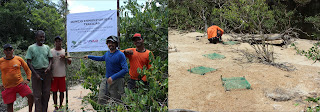The
Public Ministry of Amapá (MP-AP), represented by the Porto Grande prosecutor,
Wueber Penafort, met on Monday, 19, with representatives of the State
Government (GEA), Chico Mendes Institute for Biodiversity Conservation
(ICMBio ), Brazilian Institute of Environment and Renewable Natural Resources
(Ibama), Federal University of Amapá (Unifap), Operational Environmental
Support Center (CAOP / AMB), Ribeirinhos Association and EDP . The main questioning was related to the disappearance of the yellow
spotted freshwater turtles, which the UNIFAP studies show were caused by the
Cachoeira Caldeirao dam..
|
O Ministério Público do
Amapá (MP-AP), representado pelo promotor de justiça de Porto Grande, Wueber
Penafort, reuniu nesta segunda-feira, 19, com representantes do Governo do
Estado (GEA), Instituto Chico Mendes de Conservação da Biodiversidade
(ICMBio) Ibama, Universidade Federal do Amapá (Unifap), Centro de Apoio
Operacional do Meio Ambiente (CAOP/AMB), Associação de Ribeirinhos e empresa EDP.
O principal questionamento foi em relação ao sumiço de quelônios da espécie
tracajá, que os estudos da Unifap apontam ser efeito da barragem.
|
The
representatives of UNIFAP, ICMBio and IBAMA spoke about the company's
importance in repairing damaged areas, suggesting the action of creating artificial
beaches, which was challenged by the company, which said it was willing to
collaborate with the studies, but that the artificial beaches are not
recommended because they will not fulfill the purpose but rather attract the
public.
|
Os representantes da
Unifap, ICMBio e Ibama falaram da importância da empresa na reparação de
áreas danificadas, sugerindo a ação de repovoamento e praias artificiais, o
que foi contestado pela empresa, que disse estar disposta a colaborar com os estudos, mas que as praias
artificiais não são recomendadas porque não irão cumprir a finalidade e sim
atrair o público.
|
Full report / Relato
completo
http://www.mpap.mp.br/noticias/gerais/mp-ap-unifap-e-orgaos-ambientais-cobram-respostas-da-uhe-cachoeira-caldeirao-sobre-impacto-ambiental-e-o-sumico-dos-tracajas













